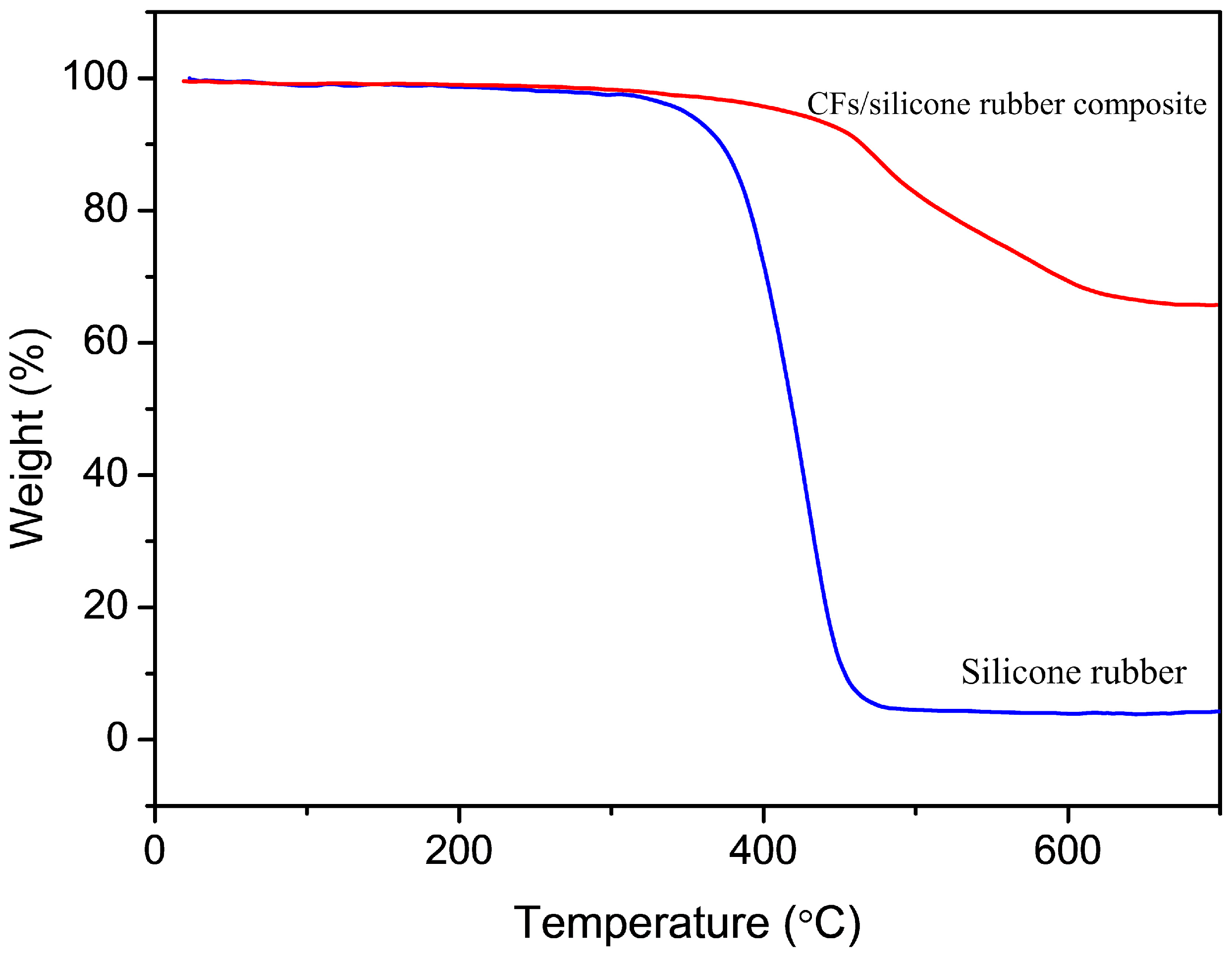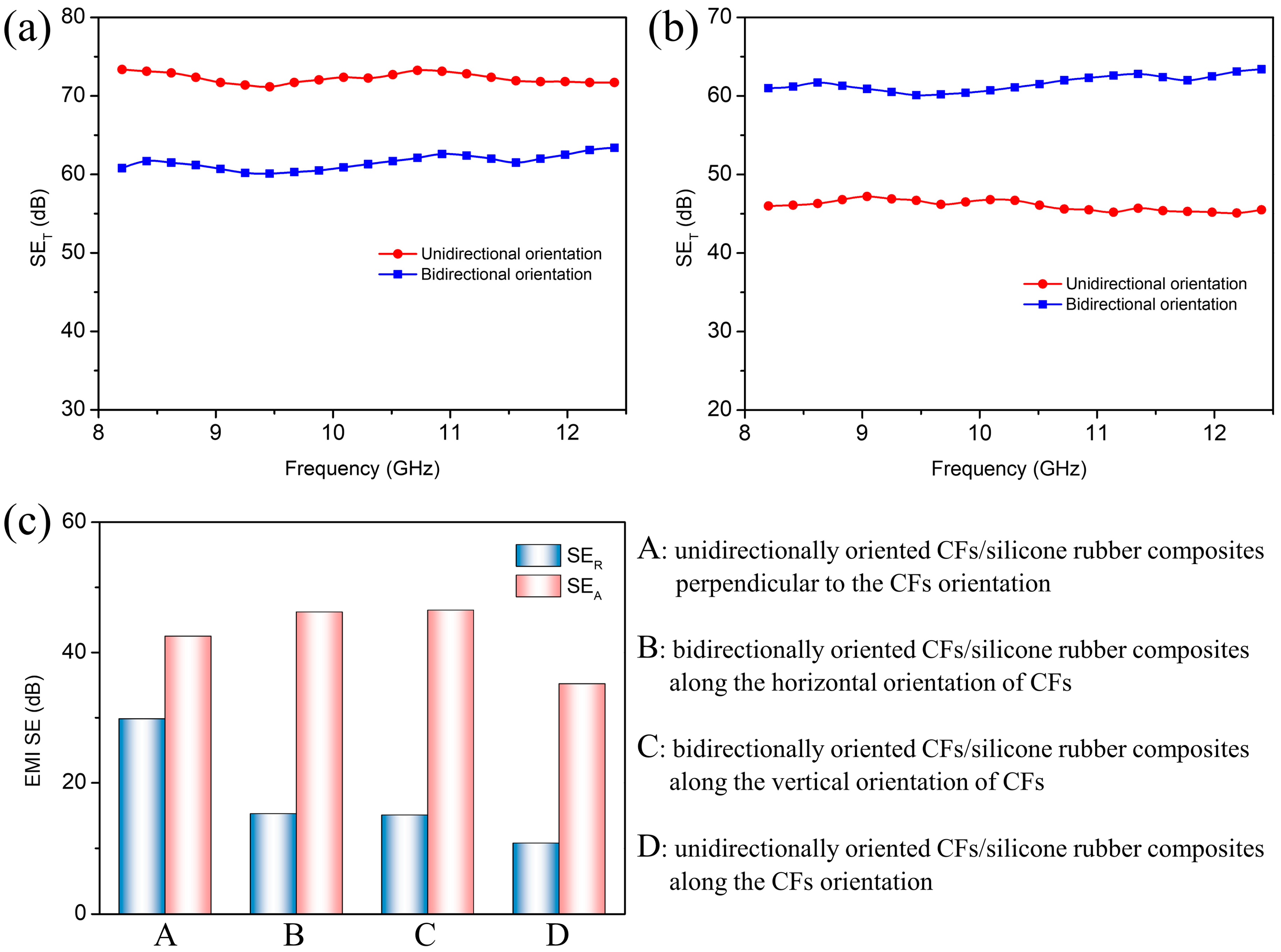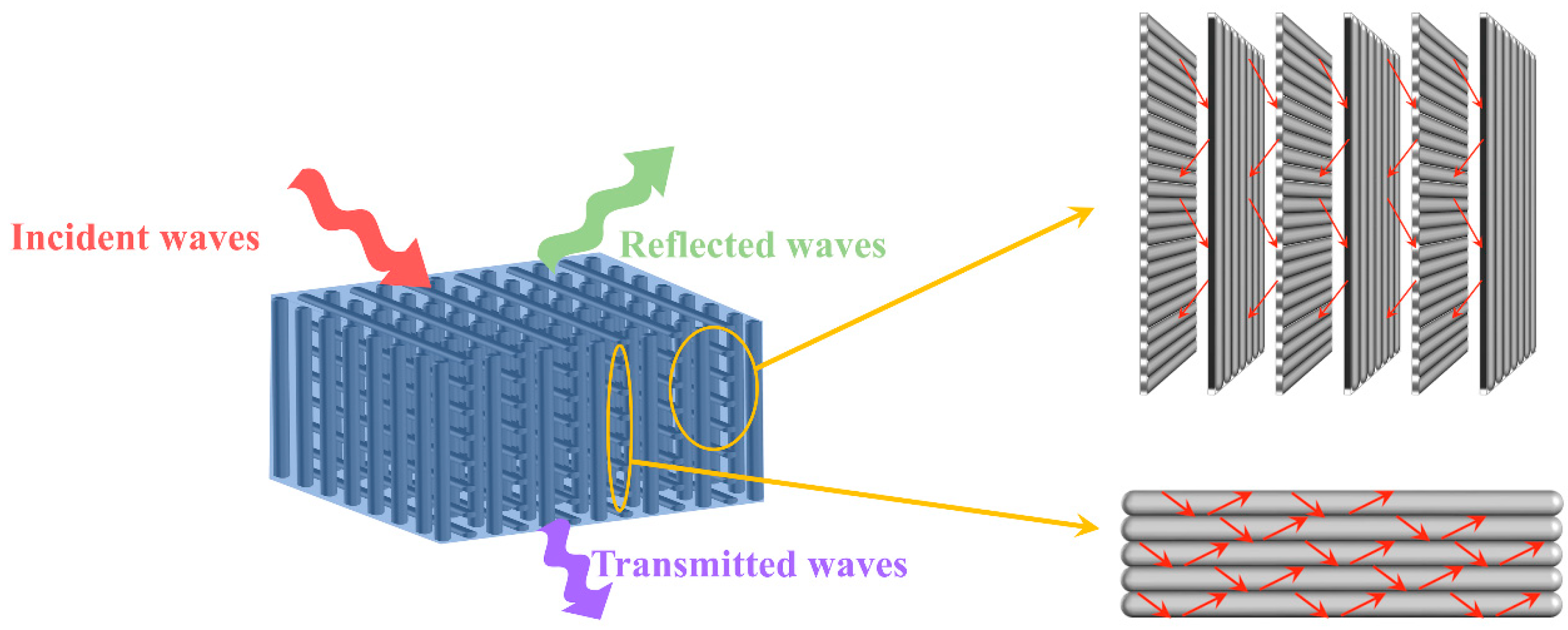Bidirectionally Oriented Carbon Fiber/Silicone Rubber Composites with a High Thermal Conductivity and Enhanced Electromagnetic Interference Shielding Effectiveness
Abstract
:1. Introduction
2. Materials and Methods
2.1. Materials
2.2. Preparation of Bidirectionally Oriented CF/Silicone Rubber Composites
2.3. Characterization
3. Results and Discussion
3.1. Preparation of Bidirectionally Oriented CF/Silicone Rubber Composites
3.2. Microstructure of Bidirectionally Oriented CF/Silicone Rubber Composites
3.3. Mechanical Properties of Bidirectionally Oriented CF/Silicone Rubber Composites
3.4. Thermal Properties of Bidirectionally Oriented CF/Silicone Rubber Composites
3.5. EMI Shielding Performance of Bidirectionally Oriented CF/Silicone Rubber Composites
4. Conclusions
Author Contributions
Funding
Institutional Review Board Statement
Informed Consent Statement
Data Availability Statement
Conflicts of Interest
References
- Yan, Y.; Wu, B.; Qian, G.; Lan, H.; Alam, M.M.; Xia, R.; Qian, J. Ultra-wideband electromagnetic interference shielding effectiveness composite with elevated thermal conductivity. Compos. Part A Appl. Sci. Manuf. 2023, 167, 107430. [Google Scholar] [CrossRef]
- Kruželák, J.; Kvasničáková, A.; Džuganová, M.; Hašková, L.; Dosoudil, R.; Hudec, I. Curing, Properties and EMI Absorption Shielding of Rubber Composites Based on Ferrites and Carbon Fibres. Polymers 2023, 15, 857. [Google Scholar] [CrossRef]
- Chung, D.D.L. Materials for electromagnetic interference shielding. Mater. Chem. Phys. 2020, 255, 123587. [Google Scholar] [CrossRef]
- Yang, D.; Tao, J.-R.; Yang, Y.; He, Q.-M.; Weng, Y.-X.; Fei, B.; Wang, M. Effect interfacial size and multiple interface on electromagnetic shielding of silicon rubber/carbon nanotube composites with mixing segregated particles. Compos. Struct. 2022, 292, 115668. [Google Scholar] [CrossRef]
- Ma, R.-Y.; Yi, S.-Q.; Li, J.; Zhang, J.-L.; Sun, W.-J.; Jia, L.-C.; Yan, D.-X.; Li, Z.-M. Highly efficient electromagnetic interference shielding and superior mechanical performance of carbon nanotube/polydimethylsiloxane composite with interface-reinforced segregated structure. Compos. Sci. Technol. 2023, 232, 109874. [Google Scholar] [CrossRef]
- Das, P.; Deoghare, A.B.; Maity, S.R. Synergistically improved thermal stability and electromagnetic interference shielding effectiveness (EMI SE) of in-situ synthesized polyaniline/sulphur doped reduced graphene oxide (PANI/S-RGO) nanocomposites. Ceram. Int. 2022, 48, 11031–11042. [Google Scholar] [CrossRef]
- Zhou, J.; Liu, C.; Xia, L.; Wang, L.; Qi, C.; Zhang, G.; Tan, Z.; Ren, B.; Yuan, B. Bridge-graphene connecting polymer composite with a distinctive segregated structure for simultaneously improving electromagnetic interference shielding and flame-retardant properties. Colloids Surf. A Physicochem. Eng. Asp. 2023, 661, 130853. [Google Scholar] [CrossRef]
- Zong, Z.; Ren, F.; Guo, Z.; Lu, Z.; Jin, Y.; Zhao, Y.; Ren, P. Dual-functional carbonized loofah@GNSs-CNTs reinforced by cyanate ester composite with highly efficient electromagnetic interference shielding and thermal management. Compos. Part B Eng. 2021, 223, 109132. [Google Scholar] [CrossRef]
- Shin, B.; Mondal, S.; Lee, M.; Kim, S.; Huh, Y.-I.; Nah, C. Flexible thermoplastic polyurethane-carbon nanotube composites for electromagnetic interference shielding and thermal management. Chem. Eng. J. 2021, 418, 129282. [Google Scholar] [CrossRef]
- Devi, G.; Priya, R.; Bapu, B.R.T.; Prabu, R.T.; Kumar, P.J.S.; Anusha, N. Role of carbonaceous fillers in electromagnetic interference shielding behavior of polymeric composites: A review. Polym. Compos. 2022, 43, 7701–7723. [Google Scholar] [CrossRef]
- Al-Saleh, M.H.; Sundararaj, U. Electromagnetic interference shielding mechanisms of CNT/polymer composites. Carbon 2009, 47, 1738–1746. [Google Scholar] [CrossRef]
- Gupta, S.; Tai, N.-H. Carbon materials and their composites for electromagnetic interference shielding effectiveness in X-band. Carbon 2019, 152, 159–187. [Google Scholar] [CrossRef]
- Wei, B.; Zhang, L.; Yang, S. Polymer composites with expanded graphite network with superior thermal conductivity and electromagnetic interference shielding performance. Chem. Eng. J. 2021, 404, 126437. [Google Scholar] [CrossRef]
- Zhao, H.; Huanga, Y.; Yun, J.; Wang, Z.; Han, Y.; Zheng, Y.; Chen, L. Stretchable polymer composite film based on pseudo-high carbon-filler loadings for electromagnetic interference shielding. Compos. Part A 2022, 157, 106937. [Google Scholar] [CrossRef]
- Thi, T.B.N.; Ata, S.; Morimoto, T.; Kato, Y.; Horibe, M.; Yamada, T.; Okazaki, T.; Hata, K. Annealing-induced enhancement of electrical conductivity and electromagnetic interference shielding in injection-molded CNT polymer composites. Polymer 2022, 245, 124680. [Google Scholar] [CrossRef]
- Li, Z.; Zhu, X.; Zhang, X.; Guo, S. Isotropic porous graphite foam/epoxy composites with outstanding heat dissipation and excellent electromagnetic interference shielding performances. Chem. Eng. J. 2023, 452, 139665. [Google Scholar] [CrossRef]
- Li, C.; Yang, Z.; Zhang, X.; Ru, Y.; Gao, D.; Wu, D.; Sun, J. Ultrasonic-Assisted Method for the Preparation of Carbon Nanotube-Graphene/Polydimethylsiloxane Composites with Integrated Thermal Conductivity, Electromagnetic Interference Shielding, and Mechanical Performances. Int. J. Mol. Sci. 2022, 23, 15007. [Google Scholar] [CrossRef] [PubMed]
- Jia, Y.; Ajayi, T.D.; Wahls, B.H.; Ramakrishnan, K.R.; Ekkad, S.; Xu, C. Multifunctional Ceramic Composite System for Simultaneous Thermal Protection and Electromagnetic Interference Shielding for Carbon Fiber-Reinforced Polymer Composites. ACS Appl. Mater. Interfaces 2020, 12, 58005–58017. [Google Scholar] [CrossRef] [PubMed]
- Jung, S.; Cho, D. Effect of fiber feeding route upon extrusion process on the electromagnetic, mechanical, and thermal properties of nickel-coated carbon fiber/polypropylene composites. Compos. Part B Eng. 2020, 187, 107861. [Google Scholar] [CrossRef]
- Mikinka, E.; Siwak, M. Recent advances in electromagnetic interference shielding properties of carbon-fibre-reinforced polymer composites-a topical review. J. Mater. Sci. Mater. Electron. 2021, 32, 24585–24643. [Google Scholar] [CrossRef]
- Choi, B.-K.; Lee, H.-J.; Choi, W.-K.; Lee, M.-K.; Park, J.-H.; Hwang, J.-Y.; Seo, M.-K. Effect of carbon fiber content on thermal and electrical conductivity, EMI shielding efficiency, and radiation energy of CMC/PVA composite papers with carbon fibers. Synth. Met. 2021, 273, 116708. [Google Scholar] [CrossRef]
- Wen, B.; Wang, X.; Zhang, Y. Ultrathin and anisotropic polyvinyl butyral/Ni-graphite/short-cut carbon fibre film with high electromagnetic shielding performance. Compos. Sci. Technol. 2019, 169, 127–134. [Google Scholar] [CrossRef]
- Tran, T.T.V.; Vo, D.-V.N.; Nguyen, S.T.; Vu, C.M. Silver nanowires decorated recycled cigarette filters based epoxy composites with high through-plane thermal conductivity and efficient electromagnetic interference shielding. Compos. Part A Appl. Sci. Manuf. 2021, 149, 106485. [Google Scholar] [CrossRef]
- Mani, D.; Vu, M.C.; Lim, C.-S.; Kim, J.-B.; Jeong, T.-H.; Kim, H.J.; Islam, M.A.; Lim, J.-H.; Kim, K.-M.; Kim, S.-R. Stretching induced alignment of graphene nanoplatelets in polyurethane films for superior in-plane thermal conductivity and electromagnetic interference shielding. Carbon 2023, 201, 568–576. [Google Scholar] [CrossRef]
- Yang, X.; Fan, S.; Li, Y.; Guo, Y.; Li, Y.; Ruan, K.; Zhang, S.; Zhang, J.; Kong, J.; Gu, J. Synchronously improved electromagnetic interference shielding and thermal conductivity for epoxy nanocomposites by constructing 3D copper nanowires/thermally annealed graphene aerogel framework. Compos. Part A Appl. Sci. Manuf. 2020, 128, 105670. [Google Scholar] [CrossRef]
- Gao, Q.; Pan, Y.; Zheng, G.; Liu, C.; Shen, C.; Liu, X. Flexible multilayered MXene/thermoplastic polyurethane films with excellent electromagnetic interference shielding, thermal conductivity, and management performances. Adv. Compos. Hybrid Mater. 2021, 4, 274–285. [Google Scholar] [CrossRef]
- Huan, X.; Wu, T.; Yan, J.; Jia, X.; Zu, L.; Sui, G.; Yang, X. Phosphoric acid derived efficient reclaimation of carbon fibre for re-manufacturing high performance epoxy composites reinforced by highly-aligned mat with optimized layup. Compos. Part B Eng. 2021, 211, 108656. [Google Scholar] [CrossRef]
- Lee, S.; Park, D.; Cho, Y.; Lee, J.; Kim, J. Highly thermally conductive and EMI shielding composite reinforced with aligned carbon fibers and MXene. Synth. Met. 2022, 291, 117183. [Google Scholar] [CrossRef]
- Zhang, Y.; Gu, J. A Perspective for Developing Polymer-Based Electromagnetic Interference Shielding Composites. Nano-Micro Lett. 2022, 14, 89. [Google Scholar] [CrossRef]
- Cheng, J.; Li, C.; Xiong, Y.; Zhang, H.; Raza, H.; Ullah, S.; Wu, J.; Zheng, G.; Cao, Q.; Zhang, D.; et al. Recent Advances in Design Strategies and Multifunctionality of Flexible Electromagnetic Interference Shielding Materials. Nano-Micro Lett. 2022, 14, 80. [Google Scholar] [CrossRef]
- Wang, M.; Tang, X.-H.; Cai, J.-H.; Wu, H.; Shen, J.-B.; Guo, S.-Y. Construction, mechanism and prospective of conductive polymer composites with multiple interfaces for electromagnetic interference shielding: A review. Carbon 2021, 177, 377–402. [Google Scholar] [CrossRef]
- Zhang, X.; Song, J.; Meng, J.; Zhang, K. Anisotropic PDMS/Alumina/Carbon Fiber Composites with a High Thermal Conductivity and an Electromagnetic Interference Shielding Performance. Materials 2022, 15, 8078. [Google Scholar] [CrossRef]
- Wu, B.; Qian, G.; Yan, Y.; Alam, M.M.; Xia, R.; Qian, J. Design of Interconnected Carbon Fiber Thermal Management Composites with Effective EMI Shielding Activity. ACS Appl. Mater. Interfaces 2022, 14, 49082–49093. [Google Scholar] [CrossRef] [PubMed]
- Zhang, Z.; Wang, J.; Shang, J.; Xu, Y.; Wan, Y.J.; Lin, Z.; Sun, R.; Hu, Y. A Through-Thickness Arrayed Carbon Fibers Elastomer with Horizontal Segregated Magnetic Network for Highly Efficient Thermal Management and Electromagnetic Wave Absorption. Small 2023, 19, e2205716. [Google Scholar] [CrossRef] [PubMed]
- Ding, D.; Huang, R.; Wang, X.; Zhang, S.; Wu, Y.; Zhang, X.-A.; Qin, G.; Liu, Z.; Zhang, Q.; Chen, Y. Thermally conductive silicone rubber composites with vertically oriented carbon fibers: A new perspective on the heat conduction mechanism. Chem. Eng. J. 2022, 441, 136104. [Google Scholar] [CrossRef]
- Li, S.; Jin, Y.; Wang, Z.; He, Q.; Chen, R.; Wang, J.; Wu, H.; Zhao, X.; Mu, J. Preparation and characterisation of nickel-plated carbon fibre/polyether ether ketone composites with high electromagnetic shielding and high thermal conductivity. Colloid Polym. Sci. 2019, 297, 967–977. [Google Scholar] [CrossRef]








| Filler | Matrix | Filler Content | TC (W∙m−1∙K−1) | SE (dB) | Ref. |
|---|---|---|---|---|---|
| Ni-graphite/CFs | Polyvinyl butyral | 45 wt% | / | 32.0 | [22] |
| CFs | epoxy | 40 vol% | / | 46.4 | [27] |
| CF/Mxene | epoxy | 25 wt% | 1.96 | 14.0 | [28] |
| CF/Al2O3 | Silicone rubber | 40.5 vol% | 8.44 | 40.8 | [32] |
| CNTs/CFs | epoxy | 34.5 wt% | 7.50 | 38.4 | [33] |
| NiCO@CFs | Silicone rubber | 53 wt% | 15.5 | 55.2 | [34] |
| CFs | Silicone rubber | 9.0 vol% | 4.72 | / | [35] |
| Ni-CFs | Polyether ether ketone | 40 wt% | 0.59 | 29.0 | [36] |
| CFs | Silicone rubber | 62.3 wt% | 25.3 | 61.6 | This work |
Disclaimer/Publisher’s Note: The statements, opinions and data contained in all publications are solely those of the individual author(s) and contributor(s) and not of MDPI and/or the editor(s). MDPI and/or the editor(s) disclaim responsibility for any injury to people or property resulting from any ideas, methods, instructions or products referred to in the content. |
© 2023 by the authors. Licensee MDPI, Basel, Switzerland. This article is an open access article distributed under the terms and conditions of the Creative Commons Attribution (CC BY) license (https://creativecommons.org/licenses/by/4.0/).
Share and Cite
Song, J.; Fan, Y.; Shi, A. Bidirectionally Oriented Carbon Fiber/Silicone Rubber Composites with a High Thermal Conductivity and Enhanced Electromagnetic Interference Shielding Effectiveness. Materials 2023, 16, 6736. https://doi.org/10.3390/ma16206736
Song J, Fan Y, Shi A. Bidirectionally Oriented Carbon Fiber/Silicone Rubber Composites with a High Thermal Conductivity and Enhanced Electromagnetic Interference Shielding Effectiveness. Materials. 2023; 16(20):6736. https://doi.org/10.3390/ma16206736
Chicago/Turabian StyleSong, Jianan, Yicheng Fan, and Anjun Shi. 2023. "Bidirectionally Oriented Carbon Fiber/Silicone Rubber Composites with a High Thermal Conductivity and Enhanced Electromagnetic Interference Shielding Effectiveness" Materials 16, no. 20: 6736. https://doi.org/10.3390/ma16206736





